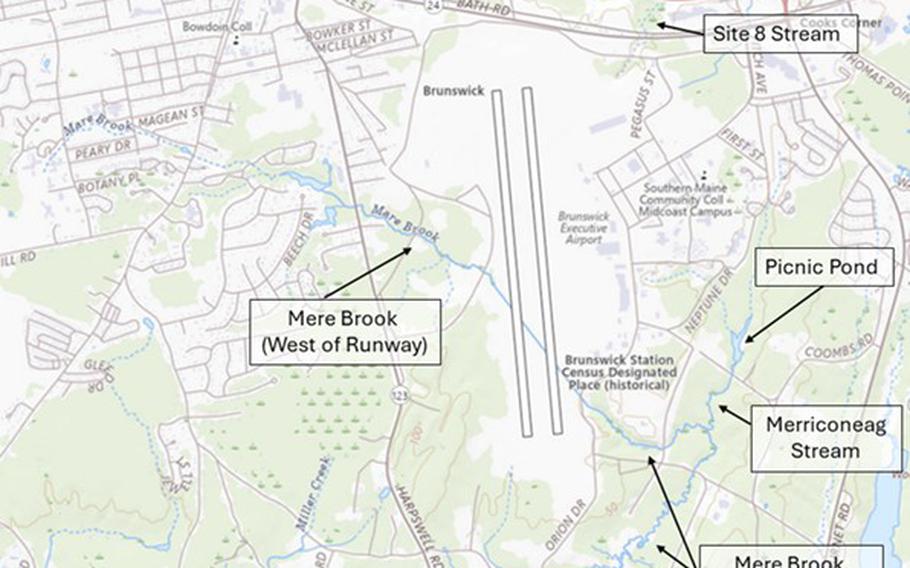
A map of waterbodies on and around the former Naval Air Station in Brunswick that may be contaminated by chemicals from a spill at the former Naval Air Station in Brunswick as of late August 2024, according to an advisory by the Maine Center for Disease Control and Prevention. (Maine DHHS)
(Tribune News Service) — The U.S. Navy must “take any and all actions necessary” to protect human health and the environment in the wake of the Aug. 19 toxic chemical spill at the former Brunswick Naval Air Station, according to the U.S. Environmental Protection Agency.
In a Sept. 26 letter, the EPA informed the Navy it “retains ultimate responsibility” to address the forever chemicals, or PFAS, left behind by the former military operation and those in the toxic firefighting foam, or AFFF, discharged by a faulty airport alarm because the Navy still owns the land.
The EPA official, Bryan Olson, doesn’t say exactly what the Navy should do to “address” the spill, but he mentions chemical testing and drinking water protections in his letter to Thuane Fielding, regional base closure manager for the Navy’s base realignment and closure program.
“Should the base cleanup team determine that private drinking water wells have or will be potentially impacted by PFAS, either due to legacy PFAS or PFAS from the recent AFFF spill, EPA expects that the Navy will conduct monitoring and take whatever other actions are necessary to ensure that drinking water sources are appropriately addressed,” Olson said.
The local authority that runs the airport now and has been leading the cleanup efforts has said it did not have enough money to pay the estimated $750,000 it will cost to clean up the spill and send the foam to a Texas incinerator for disposal.
On Tuesday, authority director Kristine Logan said she was still reviewing the contents of the letter, but noted the Navy had declined her request to help pay for the cleanup with funds it was going to spend on removing the foam from Hangar 4. That removal was scheduled just two weeks after the spill happened.
The Navy did not respond to calls or emails about the role it plans to play in the Brunswick spill cleanup.
A regional EPA spokesman, Vikram Lakshmanan, said in an email that “it is not EPA’s role to arbitrate who should have paid for the costs associated with the spill” but that “EPA expects them to incorporate the spill into their current investigation and cleanup program.”
The Navy has agreed to meet with EPA and Maine state environmental officials to discuss it, he said.
The Navy closed the base in 2011 and transferred 2,700 acres of the 3,100-acre site to the Midcoast Regional Redevelopment Authority, Brunswick and Bowdoin College. But 68 years of military operations took its environmental toll on the property, which was declared a Superfund site in 1987.
The base’s initial addition to the EPA’s national priorities list was because of water and soil contamination caused by the open-air detonation of ordnance. To date, the Navy has spent $100 million on cleanup, but local activists say more work is needed to address mounting forever chemical concerns.
At the time of the closure, the Navy knew the groundwater and soil had high levels of forever chemicals — perfluoroalkyl and polyfluoroalkyl substances, or PFAS — that were above the EPA’s health advisory, most likely left by years of firefighting foam use, Superfund records show.
At the time, federal regulators were just starting to understand that even trace amounts of some of these manmade chemicals pose a serious human health risk. High exposure over a long time can cause cancer. Exposure during critical life stages, like early childhood, can also cause life-changing harm.
Aqueous film-forming foam is used by firefighters to fight high-intensity fuel fires at military bases, fuel depots, civilian airports, fire departments and industrial plants that use a lot of chemicals, such as paper mills. The foam forms a film or blanket over the fire, depriving it of the oxygen it needs to burn.
The Navy left the barrels of AFFF it had used behind when it handed over most of the base to Midcoast Regional Redevelopment Authority. Until recently, federal airport regulators had required AFFF use at places like Brunswick Executive Airport; it now allows airports to switch to PFAS-free foam.
The authority, MRRA, now runs the airport. It was in charge on Aug. 19 when a faulty fire alarm that it knew to be deficient and overdue for inspection malfunctioned and caused 51,450 gallons of toxic AFFF to discharge 4 feet deep in Hangar 4. Initially, MRRA claimed this alarm had a clean service record.
The foam spilled out into the parking lot, floated away in the wind, and emptied into storm and sewer drains bound for nearby Harpswell Cove and the Androscoggin River before the authority was able to call Clean Harbors in to start trying to contain and retrieve as much of the foam as possible.
An unknown mixture of AFFF concentrate remains ready to use in case of fire in Hangars 5 and 6. The Navy does not own that land. At Brunswick’s insistence, MRRA hired a consultant to repair their faulty alarms and another to recommend PFAS-free foam alternatives, but conversion could cost $8 million.
The Navy has kept a low profile since the accidental discharge, which EPA records show is the sixth-largest U.S. spill in 30 years, behind others in Florida, Alabama, Arizona (which had two larger spills) and Ohio. That list, however, is likely incomplete; advocates say many spills have gone unrecorded.
In the days after the spill, the Navy referred reporter questions to the EPA, which oversees Superfund cleanups. The Restoration Advisory Board, a community advisory group the Navy formed to increase public participation in the cleanup, will hold an online meeting on Wednesday, its first since the spill.
(c)2024 the Portland Press Herald
Visit the Portland Press Herald at www.pressherald.com
Distributed by Tribune Content Agency, LLC.